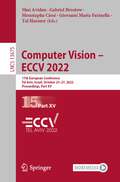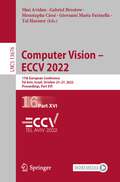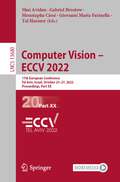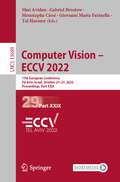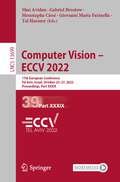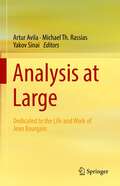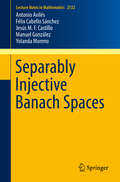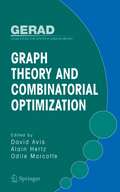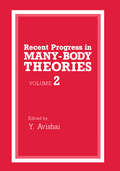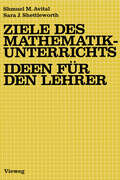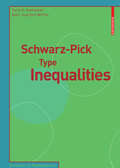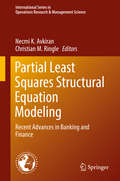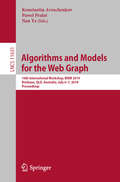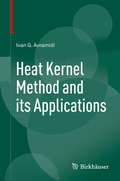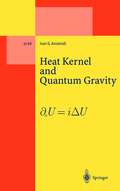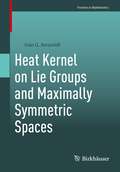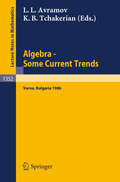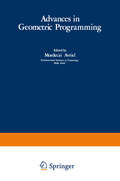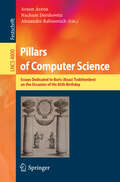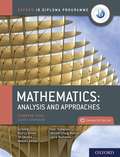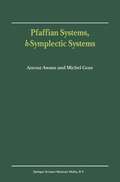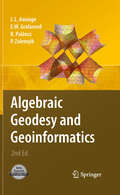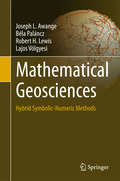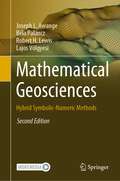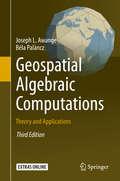- Table View
- List View
Computer Vision – ECCV 2022: 17th European Conference, Tel Aviv, Israel, October 23–27, 2022, Proceedings, Part XV (Lecture Notes in Computer Science #13675)
by Shai Avidan Gabriel Brostow Moustapha Cissé Giovanni Maria Farinella Tal HassnerThe 39-volume set, comprising the LNCS books 13661 until 13699, constitutes the refereed proceedings of the 17th European Conference on Computer Vision, ECCV 2022, held in Tel Aviv, Israel, during October 23–27, 2022. The 1645 papers presented in these proceedings were carefully reviewed and selected from a total of 5804 submissions. The papers deal with topics such as computer vision; machine learning; deep neural networks; reinforcement learning; object recognition; image classification; image processing; object detection; semantic segmentation; human pose estimation; 3d reconstruction; stereo vision; computational photography; neural networks; image coding; image reconstruction; object recognition; motion estimation.
Computer Vision – ECCV 2022: 17th European Conference, Tel Aviv, Israel, October 23–27, 2022, Proceedings, Part XVI (Lecture Notes in Computer Science #13676)
by Shai Avidan Gabriel Brostow Moustapha Cissé Giovanni Maria Farinella Tal HassnerThe 39-volume set, comprising the LNCS books 13661 until 13699, constitutes the refereed proceedings of the 17th European Conference on Computer Vision, ECCV 2022, held in Tel Aviv, Israel, during October 23–27, 2022. The 1645 papers presented in these proceedings were carefully reviewed and selected from a total of 5804 submissions. The papers deal with topics such as computer vision; machine learning; deep neural networks; reinforcement learning; object recognition; image classification; image processing; object detection; semantic segmentation; human pose estimation; 3d reconstruction; stereo vision; computational photography; neural networks; image coding; image reconstruction; object recognition; motion estimation.
Computer Vision – ECCV 2022: 17th European Conference, Tel Aviv, Israel, October 23–27, 2022, Proceedings, Part XX (Lecture Notes in Computer Science #13680)
by Shai Avidan Gabriel Brostow Moustapha Cissé Giovanni Maria Farinella Tal HassnerThe 39-volume set, comprising the LNCS books 13661 until 13699, constitutes the refereed proceedings of the 17th European Conference on Computer Vision, ECCV 2022, held in Tel Aviv, Israel, during October 23–27, 2022. The 1645 papers presented in these proceedings were carefully reviewed and selected from a total of 5804 submissions. The papers deal with topics such as computer vision; machine learning; deep neural networks; reinforcement learning; object recognition; image classification; image processing; object detection; semantic segmentation; human pose estimation; 3d reconstruction; stereo vision; computational photography; neural networks; image coding; image reconstruction; object recognition; motion estimation.
Computer Vision – ECCV 2022: 17th European Conference, Tel Aviv, Israel, October 23–27, 2022, Proceedings, Part XXIX (Lecture Notes in Computer Science #13689)
by Shai Avidan Gabriel Brostow Moustapha Cissé Giovanni Maria Farinella Tal HassnerThe 39-volume set, comprising the LNCS books 13661 until 13699, constitutes the refereed proceedings of the 17th European Conference on Computer Vision, ECCV 2022, held in Tel Aviv, Israel, during October 23–27, 2022. The 1645 papers presented in these proceedings were carefully reviewed and selected from a total of 5804 submissions. The papers deal with topics such as computer vision; machine learning; deep neural networks; reinforcement learning; object recognition; image classification; image processing; object detection; semantic segmentation; human pose estimation; 3d reconstruction; stereo vision; computational photography; neural networks; image coding; image reconstruction; object recognition; motion estimation.
Computer Vision – ECCV 2022: 17th European Conference, Tel Aviv, Israel, October 23–27, 2022, Proceedings, Part XXXIX (Lecture Notes in Computer Science #13699)
by Shai Avidan Gabriel Brostow Moustapha Cissé Giovanni Maria Farinella Tal HassnerThe 39-volume set, comprising the LNCS books 13661 until 13699, constitutes the refereed proceedings of the 17th European Conference on Computer Vision, ECCV 2022, held in Tel Aviv, Israel, during October 23–27, 2022. The 1645 papers presented in these proceedings were carefully reviewed and selected from a total of 5804 submissions. The papers deal with topics such as computer vision; machine learning; deep neural networks; reinforcement learning; object recognition; image classification; image processing; object detection; semantic segmentation; human pose estimation; 3d reconstruction; stereo vision; computational photography; neural networks; image coding; image reconstruction; object recognition; motion estimation.
Analysis at Large: Dedicated to the Life and Work of Jean Bourgain
by Artur Avila Michael Th. Rassias Yakov SinaiAnalysis at Large is dedicated to Jean Bourgain whose research has deeply influenced the mathematics discipline, particularly in analysis and its interconnections with other fields. In this volume, the contributions made by renowned experts present both research and surveys on a wide spectrum of subjects, each of which pay tribute to a true mathematical pioneer. Examples of topics discussed in this book include Bourgain’s discretized sum-product theorem, his work in nonlinear dispersive equations, the slicing problem by Bourgain, harmonious sets, the joint spectral radius, equidistribution of affine random walks, Cartan covers and doubling Bernstein type inequalities, a weighted Prékopa-Leindler inequality and sumsets with quasicubes, the fractal uncertainty principle for the Walsh-Fourier transform, the continuous formulation of shallow neural networks as Wasserstein-type gradient flows, logarithmic quantum dynamical bounds for arithmetically defined ergodic Schrödinger operators, polynomial equations in subgroups, trace sets of restricted continued fraction semigroups, exponential sums, twisted multiplicativity and moments, the ternary Goldbach problem, as well as the multiplicative group generated by two primes in Z/QZ.It is hoped that this volume will inspire further research in the areas of analysis treated in this book and also provide direction and guidance for upcoming developments in this essential subject of mathematics.
Separably Injective Banach Spaces (Lecture Notes in Mathematics #2132)
by Antonio Avilés Félix Cabello Sánchez Jesús M.F. Castillo Manuel González Yolanda MorenoThis monograph contains a detailed exposition of the up-to-date theory of separably injective spaces: new and old results are put into perspective with concrete examples (such as l∞/c0 and C(K) spaces, where K is a finite height compact space or an F-space, ultrapowers of L∞ spaces and spaces of universal disposition). It is no exaggeration to say that the theory of separably injective Banach spaces is strikingly different from that of injective spaces. For instance, separably injective Banach spaces are not necessarily isometric to, or complemented subspaces of, spaces of continuous functions on a compact space. Moreover, in contrast to the scarcity of examples and general results concerning injective spaces, we know of many different types of separably injective spaces and there is a rich theory around them. The monograph is completed with a preparatory chapter on injective spaces, a chapter on higher cardinal versions of separable injectivity and a lively discussion of open problems and further lines of research.
Graph Theory and Combinatorial Optimization (Gerad 25th Anniversary Ser. #Vol. 8)
by David Avis Alain Hertz Odile MarcotteGraph theory is very much tied to the geometric properties of optimization and combinatorial optimization. Moreover, graph theory's geometric properties are at the core of many research interests in operations research and applied mathematics. Its techniques have been used in solving many classical problems including maximum flow problems, independent set problems, and the traveling salesman problem. Graph Theory and Combinatorial Optimization explores the field's classical foundations and its developing theories, ideas and applications to new problems. The book examines the geometric properties of graph theory and its widening uses in combinatorial optimization theory and application. The field's leading researchers have contributed chapters in their areas of expertise.
Recent Progress in Many-Body Theories: Volume 2
by Y. AvishaiThe present volume contains the texts of the invited talks delivered at the Sixth International Conference on Recent Progress in Many-Body Theories held in Arad, Israel during the period November 5-10 1989. The host institute was the Physics Department at the Ben Gurion University of the Negev. Beside the invited talks there have been also two poster sessions. The general format and style of the meeting followed closely those which had preceded it and evolved from the earlier conferences in the series: Trieste 1978, Oxtapec 1981, Altenberg 1983, San Francisco 1985 and Oulu 1987. The conferences in this series are intended to cover the broad spectrum of modem physics related to the many body problem. It starts on the smallest length scales in dealing with quark gluon plasmas and ends on the largest length scales in tackling many body problems in astrophysics. In between, it is concerned with nuclear physics, solid state physics, statistical mechanics, field theory, molecular dynamics, hydrodynamics, chaos, etc. Like in the Oulu conference, special emphasis has been put on recent developments in high Tc superconductivity. Beside the half day session devoted to it we have also organized an evening round table discussion on the future of the whole subject. Furthermore, a new, and in the opinion of the editor a very refreshing element which was absent in earlier conferences was the presentation of a few talks by experimentalists.
Ziele des Mathematikunterrichts — Ideen für den Lehrer: Ideen für d. Lehrer
by Shmuel M. Avital Sara J. ShettleworthPartial Least Squares Structural Equation Modeling: Recent Advances in Banking and Finance (International Series in Operations Research & Management Science #267)
by Necmi K. Avkiran Christian M. RingleThis book pulls together robust practices in Partial Least Squares Structural Equation Modeling (PLS-SEM) from other disciplines and shows how they can be used in the area of Banking and Finance. In terms of empirical analysis techniques, Banking and Finance is a conservative discipline. As such, this book will raise awareness of the potential of PLS-SEM for application in various contexts. PLS-SEM is a non-parametric approach designed to maximize explained variance in latent constructs. Latent constructs are directly unobservable phenomena such as customer service quality and managerial competence. Explained variance refers to the extent we can predict, say, customer service quality, by examining other theoretically related latent constructs such as conduct of staff and communication skills. Examples of latent constructs at the microeconomic level include customer service quality, managerial effectiveness, perception of market leadership, etc.; macroeconomic-level latent constructs would be found in contagion of systemic risk from one financial sector to another, herd behavior among fund managers, risk tolerance in financial markets, etc. Behavioral Finance is bound to provide a wealth of opportunities for applying PLS-SEM. The book is designed to expose robust processes in application of PLS-SEM, including use of various software packages and codes, including R. PLS-SEM is already a popular tool in marketing and management information systems used to explain latent constructs. Until now, PLS-SEM has not enjoyed a wide acceptance in Banking and Finance. Based on recent research developments, this book represents the first collection of PLS-SEM applications in Banking and Finance. This book will serve as a reference book for those researchers keen on adopting PLS-SEM to explain latent constructs in Banking and Finance.
Algorithms and Models for the Web Graph: 16th International Workshop, WAW 2019, Brisbane, QLD, Australia, July 6–7, 2019, Proceedings (Lecture Notes in Computer Science #11631)
by Konstantin Avrachenkov Paweł Prałat Nan YeThis book constitutes the proceedings of the 16th International Workshop on Algorithms and Models for the Web Graph, WAW 2019, held in Brisbane, QLD, Australia, in July 2019. The 9 full papers presented in this volume were carefully reviewed and selected from 13 submissions. The papers cover topics of all aspects of algorithmic and mathematical research in the areas pertaining to the World Wide Web, espousing the view of complex data as networks.
Heat Kernel Method and its Applications
by Ivan AvramidiThe heart of the book is the development of a short-time asymptotic expansion for the heat kernel. This is explained in detail and explicit examples of some advanced calculations are given. In addition some advanced methods and extensions, including path integrals, jump diffusion and others are presented. The book consists of four parts: Analysis, Geometry, Perturbations and Applications. The first part shortly reviews of some background material and gives an introduction to PDEs. The second part is devoted to a short introduction to various aspects of differential geometry that will be needed later. The third part and heart of the book presents a systematic development of effective methods for various approximation schemes for parabolic differential equations. The last part is devoted to applications in financial mathematics, in particular, stochastic differential equations. Although this book is intended for advanced undergraduate or beginning graduate students in, it should also provide a useful reference for professional physicists, applied mathematicians as well as quantitative analysts with an interest in PDEs.
Heat Kernel on Lie Groups and Maximally Symmetric Spaces (Frontiers in Mathematics)
by Ivan G. AvramidiThis monograph studies the heat kernel for the spin-tensor Laplacians on Lie groups and maximally symmetric spaces. It introduces many original ideas, methods, and tools developed by the author and provides a list of all known exact results in explicit form – and derives them – for the heat kernel on spheres and hyperbolic spaces. Part I considers the geometry of simple Lie groups and maximally symmetric spaces in detail, and Part II discusses the calculation of the heat kernel for scalar, spinor, and generic Laplacians on spheres and hyperbolic spaces in various dimensions. This text will be a valuable resource for researchers and graduate students working in various areas of mathematics – such as global analysis, spectral geometry, stochastic processes, and financial mathematics – as well in areas of mathematical and theoretical physics – including quantum field theory, quantum gravity, string theory, and statistical physics.
Algebra. Some Current Trends: Proceedings of the 5th National School in Algebra, held in Varna, Bulgaria, Sept. 24 - Oct. 4, 1986 (Lecture Notes in Mathematics #1352)
by Luchezar L. Avramov Kerope B. TchakerianAdvances in Geometric Programming (Mathematical Concepts and Methods in Science and Engineering #21)
by Mordecai AvrielIn 1961, C. Zener, then Director of Science at Westinghouse Corpora tion, and a member of the U. S. National Academy of Sciences who has made important contributions to physics and engineering, published a short article in the Proceedings of the National Academy of Sciences entitled" A Mathe matical Aid in Optimizing Engineering Design. " In this article Zener considered the problem of finding an optimal engineering design that can often be expressed as the problem of minimizing a numerical cost function, termed a "generalized polynomial," consisting of a sum of terms, where each term is a product of a positive constant and the design variables, raised to arbitrary powers. He observed that if the number of terms exceeds the number of variables by one, the optimal values of the design variables can be easily found by solving a set of linear equations. Furthermore, certain invariances of the relative contribution of each term to the total cost can be deduced. The mathematical intricacies in Zener's method soon raised the curiosity of R. J. Duffin, the distinguished mathematician from Carnegie Mellon University who joined forces with Zener in laying the rigorous mathematical foundations of optimizing generalized polynomials. Interes tingly, the investigation of optimality conditions and properties of the optimal solutions in such problems were carried out by Duffin and Zener with the aid of inequalities, rather than the more common approach of the Kuhn-Tucker theory.
Pillars of Computer Science: Essays Dedicated to Boris (Boaz) Trakhtenbrot on the Occasion of His 85th Birthday (Lecture Notes in Computer Science #4800)
by Arnon Avron Nachum Dershowitz Alexander RabinovichMathematics: Analysis and Approaches. Standard Level. Course Companion. (PDF)
by Natasha AwadaWritten by experienced practitioners and developed in cooperation with the IB, this conceptbased print and enhanced online course book pack offers the most comprehensive support for the new DP Mathematics: analysis and approaches SL syllabus, for first assessment in 2021.
Pfaffian Systems, k-Symplectic Systems
by A. Awane M. GozeThe theory of foliations and contact forms have experienced such great de velopment recently that it is natural they have implications in the field of mechanics. They form part of the framework of what Jean Dieudonne calls "Elie Cartan's great theory ofthe Pfaffian systems", and which even nowa days is still far from being exhausted. The major reference work is. without any doubt that of Elie Cartan on Pfaffian systems with five variables. In it one discovers there the bases of an algebraic classification of these systems, their methods of reduction, and the highlighting ofthe first fundamental in variants. This work opens to us, even today, a colossal field of investigation and the mystery of a ternary form containing the differential invariants of the systems with five variables always deligthts anyone who wishes to find out about them. One of the goals of this memorandum is to present this work of Cartan - which was treated even more analytically by Goursat in its lectures on Pfaffian systems - in order to expound the classifications currently known. The theory offoliations and contact forms appear in the study ofcompletely integrable Pfaffian systems of rank one. In each of these situations there is a local model described either by Frobenius' theorem, or by Darboux' theorem. It is this type of theorem which it would be desirable to have for a non-integrable Pfaffian system which may also be of rank greater than one.
Algebraic Geodesy and Geoinformatics
by Joseph L. Awange Erik W. Grafarend Béla Paláncz Piroska ZaletnyikWhile preparing and teaching ‘Introduction to Geodesy I and II’ to undergraduate students at Stuttgart University, we noticed a gap which motivated the writing of the present book: Almost every topic that we taught required some skills in algebra, and in particular, computer algebra! From positioning to transformation problems inherent in geodesy and geoinformatics, knowledge of algebra and application of computer algebra software were required. In preparing this book therefore, we have attempted to put together basic concepts of abstract algebra which underpin the techniques for solving algebraic problems. Algebraic computational algorithms useful for solving problems which require exact solutions to nonlinear systems of equations are presented and tested on various problems. Though the present book focuses mainly on the two ?elds, the concepts and techniques presented herein are nonetheless applicable to other ?elds where algebraic computational problems might be encountered. In Engineering for example, network densi?cation and robotics apply resection and intersection techniques which require algebraic solutions. Solution of nonlinear systems of equations is an indispensable task in almost all geosciences such as geodesy, geoinformatics, geophysics (just to mention but a few) as well as robotics. These equations which require exact solutions underpin the operations of ranging, resection, intersection and other techniques that are normally used. Examples of problems that require exact solutions include; • three-dimensional resection problem for determining positions and orientation of sensors, e. g. , camera, theodolites, robots, scanners etc.
Mathematical Geosciences: Hybrid Symbolic-Numeric Methods
by Joseph L. Awange Béla Paláncz Robert H. Lewis Lajos VölgyesiThis book showcases powerful new hybrid methods that combine numerical and symbolic algorithms. Hybrid algorithm research is currently one of the most promising directions in the context of geosciences mathematics and computer mathematics in general. One important topic addressed here with a broad range of applications is the solution of multivariate polynomial systems by means of resultants and Groebner bases. But that’s barely the beginning, as the authors proceed to discuss genetic algorithms, integer programming, symbolic regression, parallel computing, and many other topics.The book is strictly goal-oriented, focusing on the solution of fundamental problems in the geosciences, such as positioning and point cloud problems. As such, at no point does it discuss purely theoretical mathematics. "The book delivers hybrid symbolic-numeric solutions, which are a large and growing area at the boundary of mathematics and computer science." Dr. Daniel Lichtbau
Mathematical Geosciences: Hybrid Symbolic-Numeric Methods
by Joseph L. Awange Béla Paláncz Robert H. Lewis Lajos VölgyesiThis second edition of Mathematical Geosciences book adds five new topics: Solution equations with uncertainty, which proposes two novel methods for solving nonlinear geodetic equations as stochastic variables when the parameters of these equations have uncertainty characterized by probability distribution. The first method, an algebraic technique, partly employs symbolic computations and is applicable to polynomial systems having different uncertainty distributions of the parameters. The second method, a numerical technique, uses stochastic differential equation in Ito form; Nature Inspired Global Optimization where Meta-heuristic algorithms are based on natural phenomenon such as Particle Swarm Optimization. This approach simulates, e.g., schools of fish or flocks of birds, and is extended through discussion of geodetic applications. Black Hole Algorithm, which is based on the black hole phenomena is added and a new variant of the algorithm code is introduced and illustrated based on examples; The application of the Gröbner Basis to integer programming based on numeric symbolic computation is introduced and illustrated by solving some standard problems; An extension of the applications of integer programming solving phase ambiguity in Global Navigation Satellite Systems (GNSSs) is considered as a global quadratic mixed integer programming task, which can be transformed into a pure integer problem with a given digit of accuracy. Three alternative algorithms are suggested, two of which are based on local and global linearization via McCormic Envelopes; and Machine learning techniques (MLT) that offer effective tools for stochastic process modelling. The Stochastic Modelling section is extended by the stochastic modelling via MLT and their effectiveness is compared with that of the modelling via stochastic differential equations (SDE). Mixing MLT with SDE also known as frequently Neural Differential Equations is also introduced and illustrated by an image classification via a regression problem.
Geospatial Algebraic Computations: Theory and Applications
by Joseph Awange Béla PalánczImproved geospatial instrumentation and technology such as in laser scanning has now resulted in millions of data being collected, e.g., point clouds. It is in realization that such huge amount of data requires efficient and robust mathematical solutions that this third edition of the book extends the second edition by introducing three new chapters: Robust parameter estimation, Multiobjective optimization and Symbolic regression. Furthermore, the linear homotopy chapter is expanded to include nonlinear homotopy. These disciplines are discussed first in the theoretical part of the book before illustrating their geospatial applications in the applications chapters where numerous numerical examples are presented. The renewed electronic supplement contains these new theoretical and practical topics, with the corresponding Mathematica statements and functions supporting their computations introduced and applied. This third edition is renamed in light of these technological advancements.
